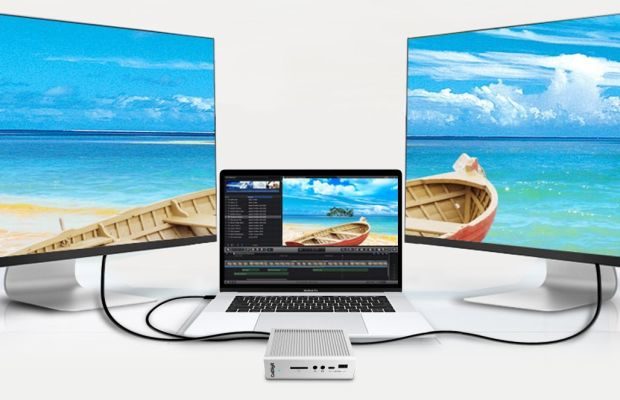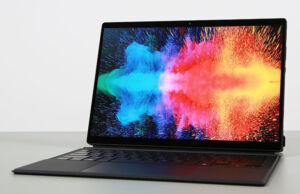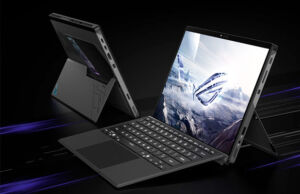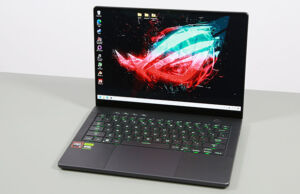Table of Contents
Laptops used to come with an array of ports, and only in the rarest of occasions would we be caught with an accessory or peripheral that we couldn’t interface with out of the box. Now, with Type-C connectors edging out legacy ports more and more, we take a look at some of the different types of Thunderbolt 3 and Type-C docks/port-replicators you might be needing to buy in the near future.
At first, it was just the Apple MacBook victims who were suddenly in need of USB Type-C dongles or Thunderbolt 3 (TB3) docks.
The rest of us mocked or pitied them. Fast-forward more than two years later, though, and USB Type-C w/ TB3 support ports are continuing their steady encroachment into our mobile devices, making “legacy” connectors such as USB Type-A, RJ-45 Ethernet, HDMI, VGA, SD card, etc. rarer and rarer.
If you don’t have a Type-C dock yet, it might be a good time to pick one up for the inevitable. But do you really need an expensive TB3 dock, or will a USB 3.1 Type-C hub do? How much should you expect to spend? The answers will very much depend on your use case, and thus this article will be divided into recommended docks/port replicators by functionality.
External Thunderbolt 4 GPU docks – from US$249
If you bring your laptop around with you daily, but also like to relax with games at home — and you don’t want to have more than one computer — a Thunderbolt 3 external GPU (eGPU) dock is for you.
While eGPUs have existed for almost a decade, the TB3 protocol brought the concept to the mainstream by making the external GPU a (mostly) plug-and-play affair. Docks that offer this functionality generally place the graphics performance as the first priority (the Lenovo TB3 Graphics Dock being an exception) and other ports as bonuses. eGPU docks tend to have fewer features than productivity-focused TB3 docks because there is only so much bandwidth to go around, and the more ports the eGPU has, the less bandwidth there is for the GPU. They are larger, more expensive, and louder than other Thunderbolt 3 docks, but nothing will make your laptop feel like a full-on desktop like an eGPU.
Not all eGPUs are created equal, however. Some of them are overpriced, lack ports, or have no power delivery over USB. In my opinion, one of the best all-around Thunderbolt 3 eGPU docks is the Mantiz Venus. The Venus (which I currently base my home setup around) is my favourite all-round TB3 dock; it not only supports a GPU, but provides five USB 3.0 Type-A ports (two on the front, three in the back), Gigabit Ethernet, and (most notably) an internal SATA connector for connecting an SSD or hard drive. The icing on the cake is that the dock can provide compatible laptops with up to 87W of power — something many cheaper docks lack.
If you are looking for an all-round single-cable solution for your home entertainment setup, a full-featured eGPU dock would be the one to get.
Productivity-focused Thunderbolt 4 docks – US$149+

CalDigit offers both a TS3 Plus and a cheaper TS3 dock, the latter of which is a bit easier to find.
If your laptop already has a beefy GPU (or you don’t plan on doing any rendering or gaming) yet you have a ton of peripherals and monitors that you want to connect with a single cable, a productivity-focused Thunderbolt 3 docking station might be what you’re after.
With TB3 providing four times the bandwidth of plain USB 3.1, these docks are faster, more fully featured, and more expensive than their USB 3.1 Type-C counterparts. As there is no way to attach a GPU to these, the size is much more compact, leading to a more flexible installation setup at your desk.
Because the majority of bandwidth isn’t needed to pipe data from a GPU to a screen, these docks are able to offer the maximum amount of ports and features (other than boosting your graphics power, of course).
The CalDigit TS3 Plus, for example, offers a bevy of ports and connections that put most other docks to shame. Highlights include: two Thunderbolt 3 ports (with passthrough), USB 3.1 Type-C, USB 3.0 Type C, and USB 3.0 Type-A ports, a DisplayPort (1.2), Gigabit Ethernet, S/PDIF Out, two 3.5mm Audio Jacks, and a fast SDXC (UHS-II) Card Reader. A must-have feature for the single-cable minimalist, the TS3 Plus provides up to 85W of power over its TB3 cable.
If you frequently work with media such as UHS cards and external HDD/SSDs while also using a multi-monitor workflow, or if you just want a one-plug solution for your rat’s nest of peripherals, you will never be left hanging with one of these docks at home or in your office.
Productivity-focused docks (USB 3.1) – US$100+

The Plugable USB-C Dock offers a lot of added functionality for USB 3.1 Type-C systems lacking TB3, but has potential compatibility issues.
If you have a laptop with Type-C ports that don’t support Thunderbolt, you’re going to be unable to benefit from the benefits of the TB3 protocol, namely, PCIe. That doesn’t mean you can’t get a pretty powerful and functional dock, however — just that you will be limited to 10Gbps speeds and no eGPU support.
The Pluggable USB-C Docking Station provides 60W of charging passthrough, four USB 3.0 Type-A ports, Gigabit Ethernet, HDMI Out (DisplayLink), DVI Output (DisplayLink), HDMI Out (VESA Alt Mode), USB-C, and audio in/out.
There are caveats, however: There is no SD card slot, and it seems that the latest version of MacOS has broken compatibility with it. In my research I’ve found that there seem to be more issues with compatibility with USB Type-C docks than Thunderbolt 3, so be sure to check the compatibility of the dock carefully before buying.
Portable Type-C adapters (USB 3.1) – US$20+
But what if you’re rarely working at home or in the office, or your laptop has USB 3.1 Type-C but no TB3 support? Then you’re probably looking for something small and portable that doesn’t need its own power supply, but you’ll have to pick and choose which functionalities are most important to you. You aren’t going to get the full functionality and speed of a stationary dock, but these adapters can still provide the basic port compatibility you need on the road.

The Letscom USB 3 adapter provides the widest variety of ports but at a relatively high price for a USB-C dock.
One of the most fully-featured Type-C adapters I could find was the Letscom Hub, which provides 87W of charging passthrough, HDMI, Gigabit Ethernet, two USB 3.0 Type-A, one USB 2.0
Type-A, and SD/TF card slot. If you don’t need the kitchen sink approach (say, for example, you don’t need Ethernet or an SD card slot), you can find cheaper options with more limited combinations of ports.
There you have it — the four main types of docks/adapters for your Type-C-woes. If you have a Thunderbolt 3 enabled laptop, you have the option of splurging on eGPU docks that add video cards up to a Titan X, internal SSDs, USB Type-A ports, Ethernet, and supply power to your laptop all with one cable. If you’re more productivity-minded, you might go for a TB3 dock with an array of nearly every port from the last 25 years, allowing you to hook up a plethora of peripherals, monitors, and storage devices (again, with a single cable).
On the other hand, if your machine lacks Thunderbolt 3 or you just need basic ability to interface with a variety of peripherals, you can get most of the similar functionality of a TB3 dock (minus PCIe-only features) at slower speeds and a slightly lower price with a USB Type-C dock. Lastly, if you just need something to provide connectivity on the road, a Type-C adapter with USB, Ethernet, HDMI, and SD card ports should keep you covered for the least amount of money.
USB Type-C isn’t going away, but the same cannot be said for our beloved Ethernet, SD, HDMI, and USB Type-A ports. A half-decade down the line, perhaps all new peripherals will be using Type-C connectors — but for the present day, you will probably need some kind of dock or adapter to ease the growing pains.
Do you have a Thunderbolt 3/ USC-C dock or adapter that works particularly well for you? Feel free to leave your experience and suggestion in the comments!













Alex R
June 8, 2018 at 8:35 pm
Thank you Douglas for this great review/suggestions about Docks… For your new Dell XPS 9570, will a "CalDigit TS3 Plus" suffice, or do you think a dock from Dell would be a better choice?
Douglas Black
June 9, 2018 at 4:40 am
Dell has a pretty spotted record with their docks, so even though you might think they'd be more compatible with XPS systems, you'd be wrong. Unless you absolutely need 130W through the TB3 cable, I think you'd get better functionality and value with another party.
Alex R
June 12, 2018 at 1:49 am
That's a good point, thank you! Please keep us posted on what dock you end up getting for your new XPS 9570 (I have the same laptop for my home office, mostly used for video editing). By the way, if you're thinking about the "Dell Thunderbolt Dock TB16 240W", here's a useful in-depth review: youtu.be/-qm6plwW1to
Alex R
June 8, 2018 at 8:43 pm
What do you think of wireless docking stations (from Dell, etc) ?
Douglas Black
June 9, 2018 at 4:39 am
Good question. I don't have any experience with them, but IIRC intel is sort of giving up on their wi-gig tech, so I am not sure how much of a future the tech really has.
Matthew Whiteman
February 25, 2019 at 1:18 pm
Hi there,
I am having an issue with getting the dedicated GPU in my laptop to work on an external monitor through a Docking station.
Laptop: Lenovo Y530, with an nVidia 1050Ti GPU. External ports on the back are USB-C 3.1 (not Thunderbolt) and a Mini DisplayPort 1.4.
Docking station is this one from Wavlink: amazon.co.uk/dp/B075T6D9PF/ref=psdc_430482031_t2_B01GK13GHQ
Basically, the Laptop refuses to use the 1050Ti when I connect it to a single external monitor via the Docking Station (Docking Station to Monitor is HDMI). It will only use the onboard Intel graphics. I have tested connecting the laptop to monitor directly with HDMI and the 1050Ti works fine when bypassing the dock. However, the wife and I all use the desk for our work laptops as well as my gaming one (we swap them regularly), so I would love to be able to consolidate the setup and not have to swap cables over all the time….that was why we bought the docking station on the first place.
I currently have a cable that connects the USB-C 3.1 port on the laptop to the USB-B 3.0 input port on the docking station.
My question is, am I using the wrong cable here? Or is what I am trying to do just not technically possible? Should I just go for a port replicator?
I am just using a single external monitor if that helps.
Assistance appreciated. Many thanks.
Douglas Black
February 25, 2019 at 2:07 pm
Don't quote me on this, but I believe the USB-B 3.0 input port doesn't accept the proper signal to use your dedicated GPU. It's a sort of emulated mode (not the right word exactly) that uses CPU power to create additional monitor supports.
Ana
April 21, 2019 at 10:31 pm
Hi. Douglas. Writing from North Argentina.
I have recently purchased a Dell Inspiron 7577 and I'm so happy about it.
I make documentaries, and sometimes I must go to old cassettes footage through a FW or 1394 port.
Some of the footage I keep stored in Lacie external disks, also with FW 400 or 800 connection ports.
Now, with this new laptop I bought, and a TH3 port it offers, how would you say I could get and settle the proper connections?
(I am aware that finding FW cables could be a hard task these days…).
Thanks so, so much for your kind help and advice on this matter.
Best,
Ana.